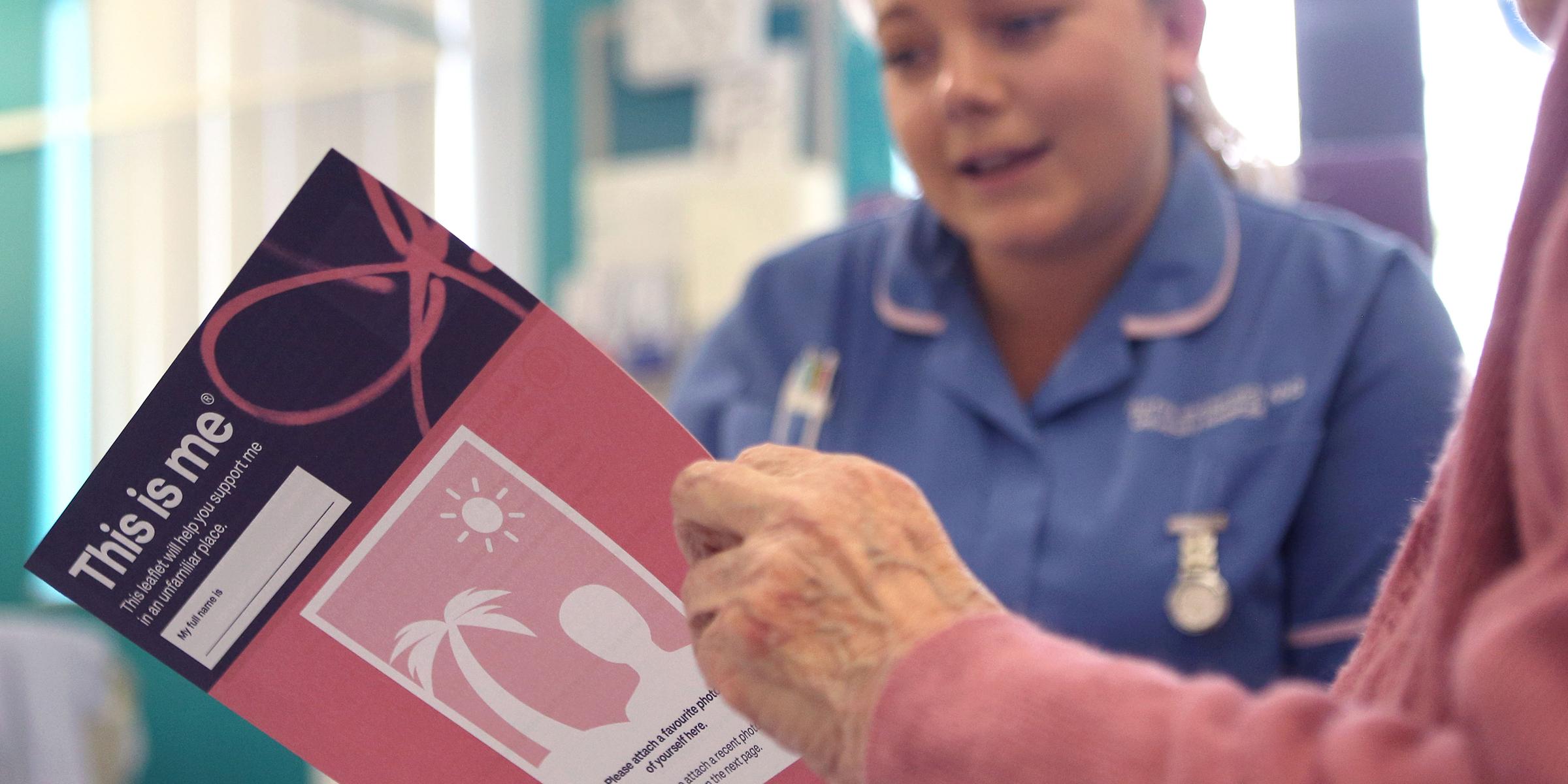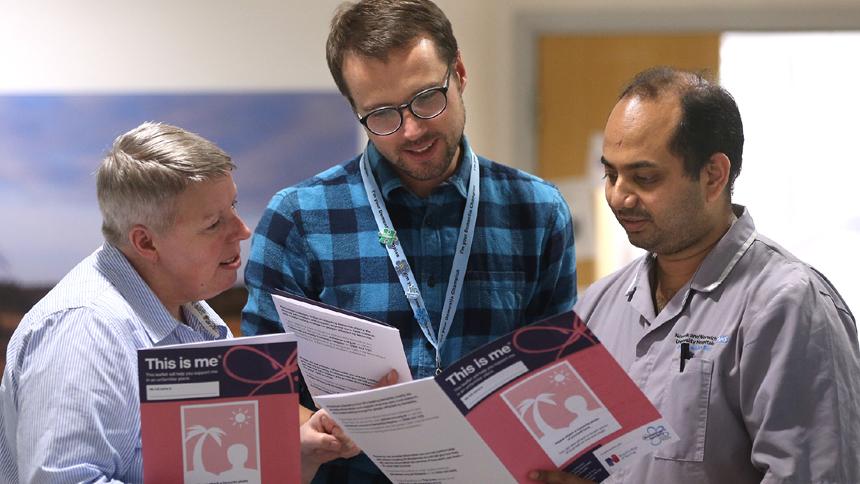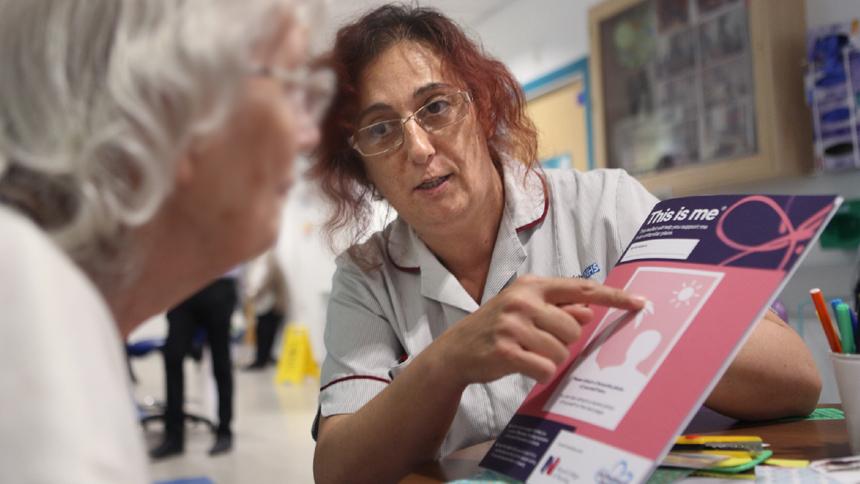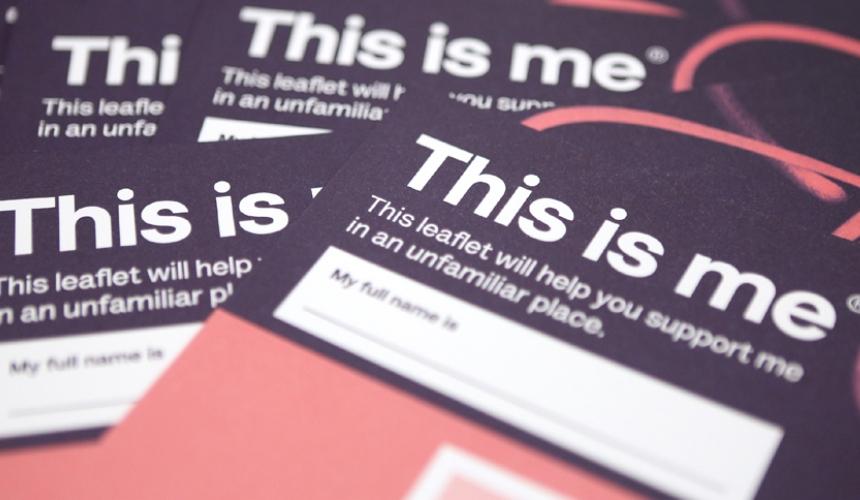
See the person: Improving care for hospital patients with dementia
‘This is me’ highlights the background and preferences of a person with dementia.
A hospital in Norwich is one of many places using our ‘This is me’ leaflet to improve care for people with dementia.
‘This is me’ is a simple way to help make sure that health and social care professionals better understand a person with dementia, whether at home, in hospital or a care home.
It’s used to record the person’s cultural and family background, their preferences and routines, and important events, people and places from their life.
‘It crystallises the things we all need to be aware of and promotes patient safety, dignity and wellbeing,’ says Liz.
‘It’s a window into their likes, dislikes and wishes,’ says Liz Yaxley, Dementia Services Manager at Norfolk and Norwich University Hospital.
‘It crystallises the things we all need to be aware of and promotes patient safety, dignity and wellbeing.’

Norfolk and Norwich underlines the importance of ‘This is me’ when training its staff. It also checks how it’s being used across the hospital to ensure that relatives and staff are making the most of it.
‘Families might see us looking busy and might not feel something is important enough to tell us, but ‘This is me’ invites them to share that information,’ says Liz.
‘If we’re not aware that someone has taken their tablet with a spoonful of yoghurt for the past two years, even the best staff aren’t going to be able to get them to take it with water. It’s that level of detail that helps us deliver the best care.’
Support our work
Help us provide reliable and useful information for people affected by dementia.
Building rapport
Staff at Norwich and Norfolk use ‘This is me’ to help reduce the anxiety than can be felt by people with dementia in unfamiliar surroundings.
‘Wards can be very busy, noisy environments that can cause distressed behaviours,’ says Theresa Gall, Assistant Practitioner. ‘“This is me” can help us build rapport with a patient by providing topics to begin conversations and form connections.
‘Talking about their career or if they are animal lovers enables staff to look through photographs with them, or maybe arrange therapy animals to visit wards. It helps see the person beyond the dementia.’
‘Having information about their hobbies and pastimes enables personalised activities to be provided to improve their quality of life,’ says Carla.
Carla Amaro, Assistant Practitioner, says ‘This is me’ helps staff support their patients to be as happy and well as possible.
‘Having information about their hobbies and pastimes enables personalised activities to be provided to improve their quality of life,’ she says.
‘Knowing their likes and dislikes can also help with menu choices and to maintain adequate nutrition and hydration.’

Spreading the message
Jamie Artherton-Howlett, Senior Dementia Support Worker, notes that even seemingly basic information can help.
‘Sometimes just knowing what the person likes to be called can help them be more at ease,’ he says.
‘This is me’ can also be used to better understand a person’s behaviour and to keep their relatives involved.
‘The emotions of carers are also very important – they like to be heard and “This is me” is really useful for that,’ says Jamie.
‘The information we gain means staff can put themselves in a patient’s shoes,’ says Jamie. ‘The emotions of carers are also very important – they like to be heard and “This is me” is really useful for that.’
Norfolk and Norwich is also promoting the use of ‘This is me’ among people with dementia who are yet to enter hospital.
‘We’re encouraging them to have it completed beforehand, so if they come to us it’s already there,’ says Liz.
‘Our quality improvement nurses working in care homes are spreading the message, and we’re working very closely with Admiral nurses and Alzheimer’s Society.
‘We want “This is me” to become a regular part of a person’s support after a dementia diagnosis.’
Massive impact
Nikki’s mother, who had vascular dementia, spent the last two weeks of her life in Norfolk and Norwich University Hospital. It was here that Nikki filled out ‘This is me’ and pinned it above the bed, hoping somebody would read it.
‘We’d been through a terrible time with Mum and I was broken when I did it,’ she says.

Nikki completed the form as if it was her mum writing it, using phrases such as ‘I have to…’ and ‘It makes me feel…’.
‘There was lots to put in there – Mum lived an amazing life,’ she says.
A nurse called Jenny read the leaflet and showed it to other staff on the ward.
‘Thank goodness Alzheimer’s Society developed “This is me”,’ says Nikki.
‘The impact was massive,’ says Nikki. ‘As soon as they read it, everyone was on board with my mum and gave her very personal care.
‘It helped get her identity back and it gave us back some hope after six years.
‘Thank goodness Alzheimer’s Society developed “This is me”.’
Nikki highlights the importance of staff taking the time to read a person’s ‘This is me’.
‘Everyone has a story, you just need people to listen,’ she says. ‘The person is still there – my mum was still human. It’s very important not to take that away.’


J
says"This is me" is a brilliant way to know basic information about the person. We always use them in our Daycare setting then it follows the person to residential care 👍a great way for professionals to work together for the needs of the person.
Carolyn whitehead
says"This is me"
About 6months ago my dad had been told he had mixed type dementia it really broke my heart . I new he had to go into hospital for a routine operation and as he was only showing mild symptoms if he was to be a bit upset they would really not have known what was wrong and why !! So I printed the whole booklet " This is me " and my dad and I filled the questions in . I took it to the hospital with me and one of the male nurses on the ward said it would make life so much easier for them when and if they needed to know about any patient with memory problems . I was quite shocked to hear that most patients that do come into hospital with memory loss have never heard of the "This is me" booklet .
More information sent to people about it would be good I think .